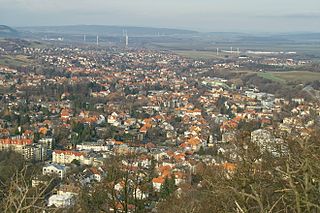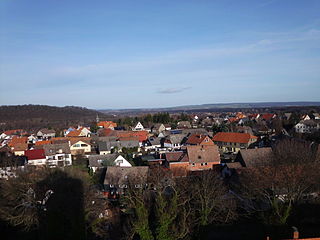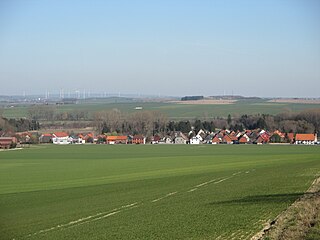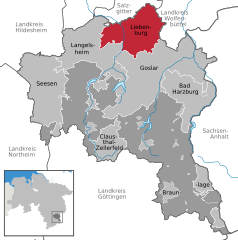Peine is a district in Lower Saxony, Germany. It is bounded by the districts of Hildesheim, Hanover and Gifhorn, and the cities of Brunswick and Salzgitter.

Salzgitter is an independent city in southeast Lower Saxony, Germany, located between Hildesheim and Braunschweig. Together with Wolfsburg and Braunschweig, Salzgitter is one of the seven Oberzentren of Lower Saxony. With 101,079 inhabitants and 223.92 square kilometres (86.46 sq mi), its area is the largest in Lower Saxony and one of the largest in Germany. Salzgitter originated as a conglomeration of several small towns and villages, and is today made up of 31 boroughs, which are relatively compact conurbations with wide stretches of open country between them. The main shopping street of the young city is in the borough of Lebenstedt, and the central business district is in the borough of Salzgitter-Bad. The city is connected to the Mittellandkanal and the Elbe Lateral Canal by a distributary. The nearest metropolises are Braunschweig, about 23 kilometres to the northeast, and Hanover, about 51 km to the northwest. The population of the City of Salzgitter has exceeded 100,000 inhabitants since its foundation in 1942, when it was still called Watenstedt-Salzgitter. Beside Wolfsburg, Leverkusen and Eisenhüttenstadt, Salzgitter is one of the few cities in Germany founded during the 20th century.
Wolfenbüttel is a district in southeastern Lower Saxony, Germany. Neighboring districts are the district-free City of Braunschweig, the district of Helmstedt, the district of Harz in Saxony-Anhalt, and the districts of Goslar, Hildesheim and Peine. The district-free city of Salzgitter cuts through the district of Wolfenbüttel in the southwest.

Wolfenbüttel is a town in Lower Saxony, Germany, the administrative capital of Wolfenbüttel District. It is best known as the location of the internationally renowned Herzog August Library and for having the largest concentration of timber-framed buildings in Germany, around 1,000. It is an episcopal see of the Evangelical Lutheran Church in Brunswick. It is also home to the Jägermeister distillery, houses a campus of the Ostfalia University of Applied Sciences, and the Landesmusikakademie of Lower Saxony.

Goslar is a historic town in Lower Saxony, Germany. It is the administrative centre of the district of Goslar and is located on the northwestern slopes of the Harz mountain range. The Old Town of Goslar with over 1.500 timber houses and the Mines of Rammelsberg are UNESCO World Heritage Sites for their millennium-long testimony to the history of ore mining and their political importance for the Holy Roman Empire and Hanseatic League. Each year Goslar awards the Kaiserring to an international artist, called the "Nobel Prize" of the art world.

Schöningen is a town of about 11,000 inhabitants in the district of Helmstedt, in Lower Saxony, Germany.

Nienburg is a town and capital of the district Nienburg, in Lower Saxony, Germany.

Bad Harzburg is a spa town in central Germany, in the Goslar district of Lower Saxony. It lies on the northern edge of the Harz mountains and is a recognised saltwater spa and climatic health resort.

Langelsheim is a town in the district of Goslar in Lower Saxony, Germany.

Seesen is a town and municipality in the district of Goslar, in Lower Saxony, Germany. It is situated on the northwestern edge of the Harz mountain range, approx. 20 km (12 mi) west of Goslar.

Vienenburg is a borough of Goslar, capital of the Goslar district, in Lower Saxony, Germany. The former independent municipality was incorporated in Goslar on 1 January 2014.

Ilsede is a municipality in the district of Peine, in Lower Saxony, Germany. It is situated on the river Fuhse, approx. 7 km south of Peine, and 20 km west of Braunschweig.

Adenbüttel is a municipality in the Gifhorn district in Lower Saxony, Germany. It is a member municipality of the Samtgemeinde Papenteich. The Municipality Adenbüttel includes the villages of Adenbüttel and Rolfsbüttel

Meine is a municipality in the district of Gifhorn, in Lower Saxony, Germany. It is a village and member municipality of the Samtgemeinde Papenteich. The Municipality Meine includes the villages of Abbesbüttel, Bechtsbüttel, Grassel, Gravenhorst, Meine, Meinholz, Martinsbüttel, Ohnhorst, Wedelheine, Wedesbüttel.

Dorstadt is a municipality in the district of Wolfenbüttel, in Lower Saxony, Germany. It is part of the Samtgemeinde Oderwald.

Heiningen is a municipality in the district of Wolfenbüttel, in Lower Saxony, Germany. It is part of the Samtgemeinde Oderwald.

The Politics of Lower Saxony takes place within a framework of a federal parliamentary representative democratic republic, where the Federal Government of Germany exercises sovereign rights with certain powers reserved to the states of Germany including Lower Saxony. Since 1948 politics in the state has been dominated by the rightist Christian Democratic Union (CDU) and the leftist Social Democratic Party. Lower Saxony was one of the origins of the German environmentalist movement in reaction to the state government's support for underground nuclear waste disposal. This led to the formation of the German Green Party in 1980.

The Hildesheim Diocesan Feud or Great Diocesan Feud, sometimes referred to as a "chapter feud", was a conflict that broke out in 1519 between the Prince-Bishopric of Hildesheim and the principalities of Brunswick-Wolfenbüttel and Calenberg that were ruled by the House of Welf. Originally just a local conflict between the Hildesheim prince-bishop John IV of Saxe-Lauenburg and his own prince-bishopric's nobility (Stiftsadel), it developed into a major dispute between various Lower Saxon territorial princes. The cause was the attempt by Prince-Bishop John to redeem the pledged estates and their tax revenue from the nobles in his temporalities, the prince-bishopric. The diocesan feud ended with the Treaty of Quedlinburg in 1523.

The Salzgitter Hills is an area of upland up to 322.9 metres (1,059 ft) in height, in the Lower Saxon Hills between Salzgitter and Goslar in the districts of Wolfenbüttel and Goslar and in the territory of the independent town of Salzgitter. The hills lie in the German federal state of Lower Saxony.

Schladen-Werla is a municipality in the district of Wolfenbüttel, in Lower Saxony, Germany. It was formed on 1 November 2013, when the municipalities of the former Samtgemeinde Schladen: Gielde, the town of Hornburg, Schladen proper, and Werlaburgdorf were merged.

























